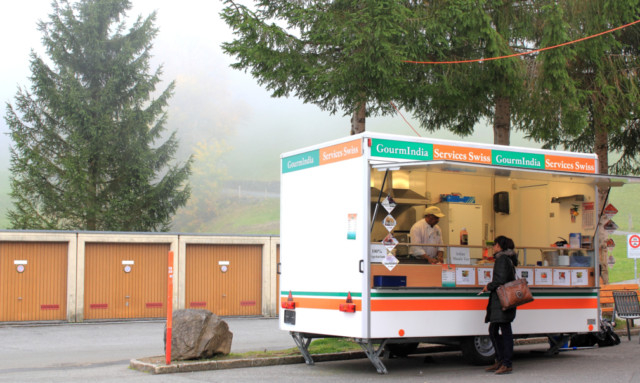
The Taj Mahal may be the location of choice for thousands of romantic proposals every year, but Indian influence extends further than its borders. In Switzerland, on the foot of Mt Titlis, the only snacking option is a stall that sells idlis (rice cakes), vada pavs (potato fritters in buns), samosas and masala chai (tea), after you have had your photograph taken under a huge cardboard cut-out of Bollywood stars Kajol and Shah Rukh Khan. Tourism Australia recently announced a strategy, which targets the high-spending Indian tourist — The India 2020 Strategic Plan. It aims to attract 300,000 Indians who are expected to spend up to Australian $2.3bn (about Dh8.9bn) a year by 2020. Even global hotel chains such as Starwood, Marriott and Accor have adapted, adding room service and all day dining options to cater to the demands of the travellers.
Tourism boards of countries such as Italy, the UK and Fiji are doing their bit to feature their locations in Bollywood movies. India’s cinema halls reach to up to 800 million filmgoers annually and the boards swear that each movie can increase the popularity of a locale manifold.
Adapting to unique guests
Food and weddings pretty much sum up the Hilton Ras Al Khaimah (RAK) experience with its Indian guests.
Speaking to GN Focus, Mohab Ghalli, Country Manager Ras Al Khaimah for Hilton Worldwide, says, “We allow them to bring their own chef who works in our kitchen with our staff. We had to adapt.”
The hotel which hosts numerous conferences and events says that it is not standard practice to allow outside chefs. “The first couple of weddings we refused. Now we only allow chefs at Indian weddings,” says Ghalli who has seen at least five in his four-year tenure at Hilton RAK.
“They require a lot of rooms, sometimes 300 or 400 at the same time. With the opening of the Waldorf Astoria in Ras Al Khaimah we can move some of the Indian wedding business from the resort,” he says.
The experience of an international brand adapting to its Indian guest is not unusual. Indians have a long tradition of spoiling guests. Indian hotel majors, whether ITC Hotels, the Taj Group, the Oberoi or the Leela Group, are proud of maintaining service standards that can set benchmarks for the best in the world.
Hospitality chain Marriott has tweaked both its Courtyard and Fairfield brands for India, introducing all day dining and mandatory room service that Indians seem to expect. When Starwood opened a Le Méridien hotel in the South Indian town of Coimbatore, it ensured that a temple was constructed inside the premises — weddings form a major part of their business and having a temple within the hotel’s perimeter is an additional guest service.
Happy to change
Both domestically and internationally, brands are happy to cater to the preferences of their Indian guests.
“At Starwood, the biggest influence the Indian traveller is making is reflected in the rapidly growing number of active Starwood Preferred Guest (SPG) programme users, which will cross 100,000 by the end of 2012 — the Indian SPG guest spends more than almost all nationalities globally,” says Dilip Puri, Starwood’s Managing Director and Regional Vice-President South Asia, in an interview with GN Focus.
The preferred guest
The high-spending Indian is indeed a preferred guest. The typical wedding party, says Ghalli, which can come from the UK, the US, Dubai or India, is upmarket. “They even fly the singers from India. At one of the events the father paid almost half a million dollars flying a popular Indian singer down to RAK to sing for a couple of hours, almost half of what he paid us. Money is not an issue. They just need top quality service.”
It is the Indian guest, they say, who is behind SPG’s recent introduction of Your24 which allows its elite guests to pick their own check-in and check-out times, keeping in mind that international flights to and from India usually land and take-off at unearthly hours.
A United Nations World Tourism Organisation report predicts that as many as 50 million outbound trips a year will be made from India by 2020. Companies who were early adapters of the India lesson, have taken long strides in the tourism space.
Take international travel services giant Kuoni, for instance. Its then India head, Zubin Karkaria is said to be responsible for the biggest success story of Kuoni India — the launch of VFS Global in 2001 — in a direct response to the nightmarish restrictions Indian tourists faced when approaching embassies for visas, even as tourism boards recognised their importance.
VFS Global was started as a specialist Business Process Outsourcing (BPO) agency to facilitate visa application procedures all over the world. Today the organisation has business operations in 50 countries handling more than eight million visa applications annually for 35 diplomatic missions. In its last year’s results, the company called its division market South Asia “one of the most important sources of earnings in 2010.” This year, according to Kuoni’s 2011 report, “India improved volumes by almost 30 per cent despite weakness of the currency.”
As Indians continue to explore the world, things can only get better since brands are going the extra mile to provide Indian fare and prompt service. “Starwood has created an ‘Indian acculturation programme’, by which several of our hotels globally in cities where there is large Indian travel, either for business, leisure or weddings have been able to better understand the Indian guest, his needs and expectations. The results are quite amazing,” says Puri.


